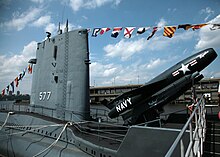
Deterrence theory refers to the scholarship and practice of how threats of using force by one party can convince another party to refrain from initiating some other course of action.[1] The topic gained increased prominence as a military strategy during the Cold War with regard to the use of nuclear weapons and is related to but distinct from the concept of mutual assured destruction, according to which a full-scale nuclear attack on a power with second-strike capability would devastate both parties. The central problem of deterrence revolves around how to credibly threaten military action or nuclear punishment on the adversary despite its costs to the deterrer.[2] Deterrence in an international relations context is the application of deterrence theory to avoid conflict.
Deterrence is widely defined as any use of threats (implicit or explicit) or limited force intended to dissuade an actor from taking an action (i.e. maintain the status quo).[3][4] Deterrence is unlike compellence, which is the attempt to get an actor (such as a state) to take an action (i.e. alter the status quo).[5][6][4] Both are forms of coercion. Compellence has been characterized as harder to successfully implement than deterrence.[6][7] Deterrence also tends to be distinguished from defense or the use of full force in wartime.[3]
Deterrence is most likely to be successful when a prospective attacker believes that the probability of success is low and the costs of attack are high.[8] Central problems of deterrence include the credible communication of threats[9][4] and assurance.[10] Deterrence does not necessarily require military superiority.[11][12]
"General deterrence" is considered successful when an actor who might otherwise take an action refrains from doing so due to the consequences that the deterrer is perceived likely to take.[13] "Immediate deterrence" is considered successful when an actor seriously contemplating immediate military force or action refrains from doing so.[13] Scholars distinguish between "extended deterrence" (the protection of allies) and "direct deterrence" (protection of oneself).[12][14] Rational deterrence theory holds that an attacker will be deterred if they believe that:[15]
(Probability of deterrer carrying out deterrent threat × Costs if threat carried out) > (Probability of the attacker accomplishing the action × Benefits of the action)
This model is frequently simplified in game-theoretic terms as:
Costs × P(Costs) > Benefits × P(Benefits)
- ^ Wragg, David W. (1973). A Dictionary of Aviation (first ed.). Osprey. p. 108. ISBN 9780850451634.
- ^ Lindsay, Jon R.; Gartzke, Erik (2019). Introduction: Cross-Domain Deterrence, from Practice to Theory. Oxford University Press. p. 2. doi:10.1093/oso/9780190908645.003.0001. ISBN 978-0-19-090960-4. Archived from the original on 2021-08-30. Retrieved 2021-08-30.
- ^ a b Morgan, Patrick M. (1977). Deterrence: A Conceptual Analysis. SAGE Publications. pp. 26–30. ISBN 978-0-8039-0819-2. Archived from the original on 2024-02-24. Retrieved 2021-08-30.
- ^ a b c Gartzke, Eric; Lindsay, Jon R. (2019). Cross-Domain Deterrence: Strategy in an Era of Complexity. Oxford University Press. doi:10.1093/oso/9780190908645.001.0001. ISBN 978-0-19-090960-4. Archived from the original on 2021-08-30. Retrieved 2021-08-30.
- ^ Art, Robert J.; Greenhill, Kelly M. (2015). The Use of Force: Military Power and International Politics. Rowman & Littlefield Publishers. pp. 3–5. ISBN 978-1-4422-3306-5. Archived from the original on 2024-02-24. Retrieved 2021-08-28.
- ^ a b Schelling, Thomas C. (1966). Arms and Influence. Yale University Press. doi:10.2307/j.ctt5vm52s. ISBN 978-0-300-00221-8. JSTOR j.ctt5vm52s. Archived from the original on 2022-05-19. Retrieved 2021-08-30.
- ^ Pape, Robert A. (1996). Bombing to Win: Air Power and Coercion in War (1 ed.). Cornell University Press. ISBN 978-0-8014-3134-0. JSTOR 10.7591/j.ctt1287f6v. Archived from the original on 2021-08-30. Retrieved 2021-08-30.
- ^ Mearsheimer, John J. (1983). Conventional Deterrence. Cornell University Press. p. 23. ISBN 978-1-5017-1325-5. JSTOR 10.7591/j.ctt1rv61v2. Archived from the original on 2023-04-05. Retrieved 2021-09-05.
- ^ Shimshoni, Jonathan (1988). Israel and Conventional Deterrence. Cornell University Press. p. 6. doi:10.7591/9781501737831. ISBN 978-1-5017-3783-1. S2CID 243305936. Archived from the original on 2021-09-06. Retrieved 2021-09-06.
- ^ Glaser, Bonnie S.; Weiss, Jessica Chen; Christensen, Thomas J. (2023-11-30). "Taiwan and the True Sources of Deterrence". Foreign Affairs. ISSN 0015-7120. Archived from the original on 2023-12-01. Retrieved 2023-12-01.
- ^ Heginbotham, Eric; Samuels, Richard J. (2018). "Active Denial: Redesigning Japan's Response to China's Military Challenge". International Security. 42 (4): 128–169. doi:10.1162/isec_a_00313. hdl:1721.1/118651. ISSN 0162-2889. S2CID 57570578. Archived from the original on 2024-02-24. Retrieved 2021-09-06.
- ^ a b Cite error: The named reference
Deterwas invoked but never defined (see the help page). - ^ a b Fearon, James (2002). "Selection Effects and Deterrence". International Interactions. 28 (1): 5–29. doi:10.1080/03050620210390. ISSN 0305-0629. S2CID 35580738. Archived from the original on 2024-02-24. Retrieved 2021-09-06.
- ^ Lee, Do Young (2021). "Strategies of Extended Deterrence: How States Provide the Security Umbrella". Security Studies. 30 (5): 761–796. doi:10.1080/09636412.2021.2010887. ISSN 0963-6412. S2CID 246241390.
- ^ Glaser, Charles L. (1990). Analyzing Strategic Nuclear Policy. Princeton University Press. p. 20. ISBN 978-1-4008-6202-3. Archived from the original on 2023-04-10. Retrieved 2021-09-18.